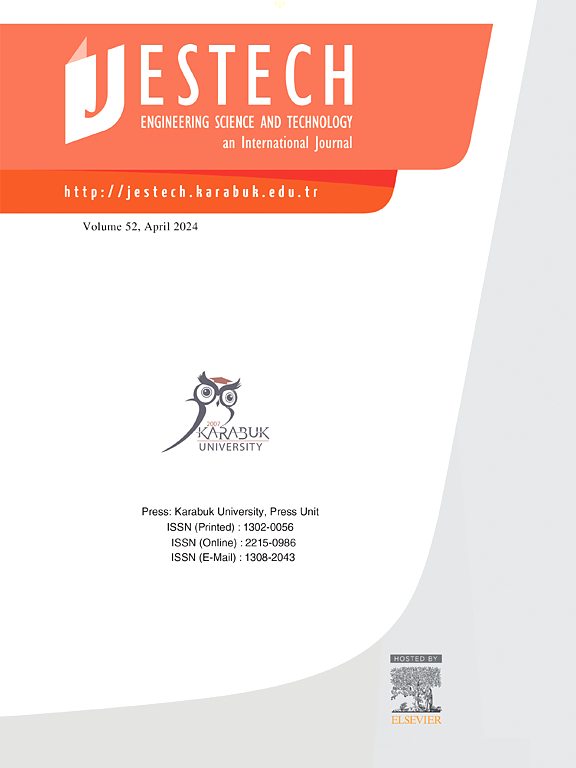一种基于逻辑算子的风电机组布局优化方法
IF 5.1
2区 工程技术
Q1 ENGINEERING, MULTIDISCIPLINARY
Engineering Science and Technology-An International Journal-Jestech
Pub Date : 2025-04-18
DOI:10.1016/j.jestch.2025.102057
引用次数: 0
摘要
如今,随着人们对可再生能源的需求日益增加,人们对风能的兴趣日益浓厚,风力发电机的使用也越来越广泛。为了有效地利用风力涡轮机发电,重要的是涡轮机在风力发电场的正确位置。本研究采用2 km × 2 km的标准风电场面积进行风力机布局。此外,与文献不同的是,还创建了一个4公里× 4公里的风电场区域。在文献中,两个风电场区域被划分为10 × 10和20 × 20网格。此外,还创建了25 × 25、40 × 40和50 × 50网格。因此,风力发电场被划分为更多的电网,并以更灵活的涡轮机定位为目标。风力涡轮机的布局有三种不同的情况。场景A风速为12 m/s,风速为单向,场景B风速为12 m/s,风速为36向10°角。情况C的风速为8、12和17米/秒,风速为36向10°角。HHO算法用于执行所有这些过程。然而,由于风电机组布局问题是二进制问题,HHO算法适用于带有逻辑算子的二进制问题。这些二进制方法被称为HHOAND和HHOXOR。与文献中的其他算法相比,所提出的方法取得了具有竞争力的结果,并且对所有网格结构都具有良好的性能。因此,可以说所提出的方法对于风力机布局问题是有效的。本文章由计算机程序翻译,如有差异,请以英文原文为准。

An efficient binary Harris hawks optimization based on logical operators for wind turbine layout according to various wind scenarios
Nowadays, with the demand for renewable energy the interest in wind energy is increasing day by day and the use of wind turbines is becoming widespread. In order to efficiently generate electricity from wind turbines, it is important that the turbines are correctly positioned on wind farms. In this study, a standard wind farm area of 2 km × 2 km was used for wind turbine layout. In addition, different from the literature, a 4 km × 4 km wind farm area was also created. Both wind farming areas were divided into 10 × 10 and 20 × 20 grids as in the literature. In addition, 25 × 25, 40 × 40 and 50 × 50 grids were also created. Thus, the wind farming area is divided into more grids and more flexible positioning of the turbines is aimed. There are three different case scenarios for the layout of the wind turbines. Case A has a constant wind speed of 12 m/s and unidirectional wind, while Case B has a constant wind speed of 12 m/s with a 36-directional 10° angle. Case C has variable wind speeds of 8, 12 and 17 m/s with a 36-directional 10° angle. The HHO algorithm was used to perform all these processes. However, since the wind turbine layout problem is binary, the HHO algorithm is adapted to binary with logic operators. These binary methods are called HHOAND and HHOXOR. The proposed methods achieved competitive results compared to other algorithms in the literature and performed well for all grid structures. Thus, it can be said that the proposed methods are effective for the wind turbine layout problem.
求助全文
通过发布文献求助,成功后即可免费获取论文全文。
去求助
来源期刊

Engineering Science and Technology-An International Journal-Jestech
Materials Science-Electronic, Optical and Magnetic Materials
CiteScore
11.20
自引率
3.50%
发文量
153
审稿时长
22 days
期刊介绍:
Engineering Science and Technology, an International Journal (JESTECH) (formerly Technology), a peer-reviewed quarterly engineering journal, publishes both theoretical and experimental high quality papers of permanent interest, not previously published in journals, in the field of engineering and applied science which aims to promote the theory and practice of technology and engineering. In addition to peer-reviewed original research papers, the Editorial Board welcomes original research reports, state-of-the-art reviews and communications in the broadly defined field of engineering science and technology.
The scope of JESTECH includes a wide spectrum of subjects including:
-Electrical/Electronics and Computer Engineering (Biomedical Engineering and Instrumentation; Coding, Cryptography, and Information Protection; Communications, Networks, Mobile Computing and Distributed Systems; Compilers and Operating Systems; Computer Architecture, Parallel Processing, and Dependability; Computer Vision and Robotics; Control Theory; Electromagnetic Waves, Microwave Techniques and Antennas; Embedded Systems; Integrated Circuits, VLSI Design, Testing, and CAD; Microelectromechanical Systems; Microelectronics, and Electronic Devices and Circuits; Power, Energy and Energy Conversion Systems; Signal, Image, and Speech Processing)
-Mechanical and Civil Engineering (Automotive Technologies; Biomechanics; Construction Materials; Design and Manufacturing; Dynamics and Control; Energy Generation, Utilization, Conversion, and Storage; Fluid Mechanics and Hydraulics; Heat and Mass Transfer; Micro-Nano Sciences; Renewable and Sustainable Energy Technologies; Robotics and Mechatronics; Solid Mechanics and Structure; Thermal Sciences)
-Metallurgical and Materials Engineering (Advanced Materials Science; Biomaterials; Ceramic and Inorgnanic Materials; Electronic-Magnetic Materials; Energy and Environment; Materials Characterizastion; Metallurgy; Polymers and Nanocomposites)
 求助内容:
求助内容: 应助结果提醒方式:
应助结果提醒方式:


